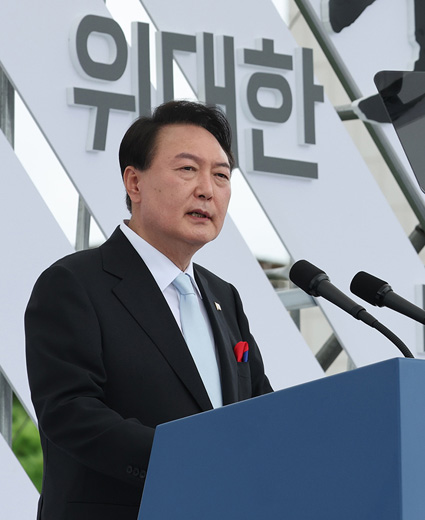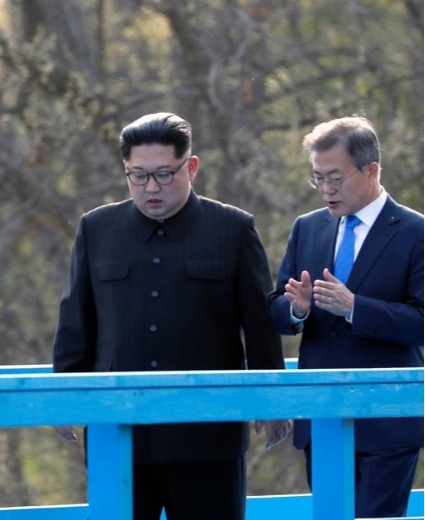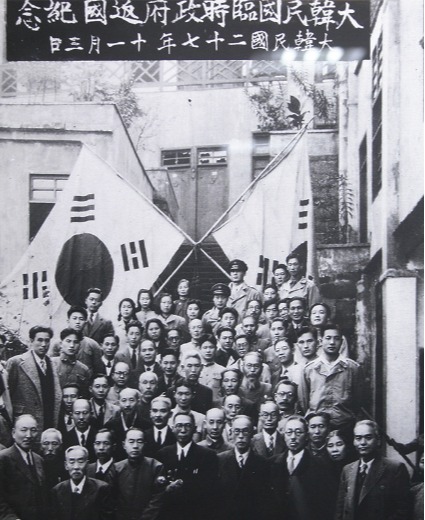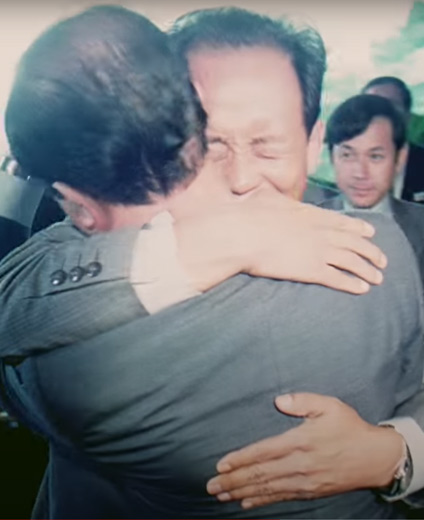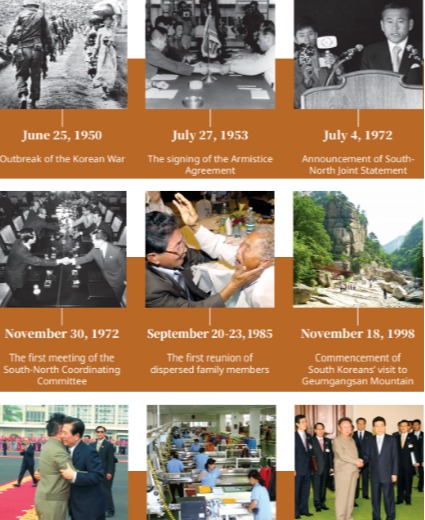-
 Korea.net's 24-hour YouTube channel
Korea.net's 24-hour YouTube channel- NEWS FOCUS
- ABOUT KOREA
- EVENTS
- RESOURCES
- GOVERNMENT
- ABOUT US
Between September 1990 and October 1992, the two Koreas engaged in a total of eight bilateral meetings, including the first high-level talks held in Seoul. In December 1991, the two sides signed the Agreement on Reconciliation, Nonaggression, and Exchanges and Cooperation between the South and the North (also called the Inter-Korean Basic Agreement). The agreement focused on mutual respect between the two nations, the renunciation of armed aggression, exchange and cooperation in many sectors, and the guarantee of free exchange of people between the two countries.
From the mid-1990s onward, the South’s government continued to provide support for the North, which was continuing to experience serious economic difficulties.
In the period 1999–2007, the South supplied a total of 2.55 million tons of fertilizers to the North in an effort to help the North Korean people who were suffering from a food shortage.
Such assistance was later suspended due to North Korea’s nuclear tests and other provocations, but humanitarian aid through private organizations resumed in 2015.
The supply of fertilizer was also an effective way to help starving North Koreans, considering that the North’s food shortage is not a temporary phenomenon but is attributable to the inefficient farming system and a lack of fertilizers and pesticides.
The Inter-Korean Summits held in 2000 and 2007 provided the momentum for a dramatic invigoration of dialogue, exchange, and cooperation between the two sides. However, the South temporarily suspended the supply of food and fertilizers after the North’s continuing series of provocative actions culminated in the launch of long-range missiles and nuclear tests, but did not stop providing humanitarian support for children or emergency relief aid.
The deployment of the Terminal High Altitude Area Defense (THAAD) system in South Korea led to some instability in the relations between neighboring powers (United States, China, Japan, and Russia). However, the Moon Jae-in administration continuously sought plans for peace. In September 2017, the Moon government deliberated and approved a plan to send humanitarian aid worth USD 8 million to North Korea at the request of an international organization under the United Nations. The South Korean government also induced North Korea to participate in the 2018 PyeongChang Winter Olympics. Such a reconciliatory mood led to the 2018 Inter-Korean Summit, paving the way for a denuclearized Korean Peninsula.
Reunion of Dispersed Family Members
It is estimated that there are about 10 million family members separated by the Korean War. Since the 1970s, South Korea and North Korea have attempted to hold reunions for war-torn families through inter-Korean Red Cross meetings. The two Koreas held Red Cross talks intermittently, including the first meeting in Pyongyang in August 1972 followed by intermittent negotiations including the 2nd meeting in Seoul in September that year, but ended up suspending such talks in 1978 after continuing controversy.
The two sides resumed meetings in the 1980s, and, finally, reached an agreement on reciprocal visits. A group of 30 people from the North paid a visit to the South while a group of 35 people from the South paid a visit to the North for four days beginning on September 20, 1985. It was a truly significant event after 40 years of division. The two sides also allowed exchanges between groups of artists during the event.
Unfortunately, those reunions have not taken place since the last event at Geumgangsan Mountain in 2015. However, the two Koreas are now considering holding various exchanges among divided families including the resumption of the August 15 family reunions as agreed in the Panmunjeom Declaration.
Kaesong Industrial Complex
Kaesong is the third largest city in North Korea along with Pyongyang and Nampo. The city offers clear advantages to businesses from South Korea, including the geographical proximity to the South. Kaesong is just 8 km away from Panmunjeom.
The Kaesong Industrial Complex, the signature project of South Korea’s Sunshine Policy, allowed private businesses from South Korea to build factories on land leased by North Korea for 50 years for the production of goods by domestic and foreign firms. Construction began in 2000, and companies started their operations in earnest in 2005. At one point, more than 120 manufacturers from South Korea employed over 50,000 North Korean workers. The project was regarded as a good example of inter-Korean economic cooperation as the complex was operated with the capital and technology of South Korea, and the labor force of North Korea.
Afterward, North Korea’s continued nuclear tests frayed bilateral ties, leading to the withdrawal of South Korean companies in February 2016.
Concerning the Kaesong Industrial Complex, the two sides have signed four agreements. One is on the normalization of the complex, and the other three on communications/customs clearance/quarantine, access, and a stay.
Since the July 4th South–North Joint Statement, the two Koreas have made efforts to improve relations by signing different agreements including the Agreement on Reconciliation, Non-Aggression, and Exchanges and Cooperation between South and North Korea (Inter-Korean Basic Agreement); the Joint Declaration of the Denuclearization of the Korean Peninsula; the June 15 SouthNorth Joint Declaration; the Agreement on the Creation and Operation of a Joint Military Commission; and the Agreement on the Establishment and Operation of the South–North Liaison Office. As the confrontational relationship came to an end with the Panmunjeom Declaration, the two Koreas are mapping out new economic plans for the Korean Peninsula through various inter-Korean exchanges including the opening of the second Kaesong Industrial Complex.
From the mid-1990s onward, the South’s government continued to provide support for the North, which was continuing to experience serious economic difficulties.
In the period 1999–2007, the South supplied a total of 2.55 million tons of fertilizers to the North in an effort to help the North Korean people who were suffering from a food shortage.
Such assistance was later suspended due to North Korea’s nuclear tests and other provocations, but humanitarian aid through private organizations resumed in 2015.
The supply of fertilizer was also an effective way to help starving North Koreans, considering that the North’s food shortage is not a temporary phenomenon but is attributable to the inefficient farming system and a lack of fertilizers and pesticides.
The Inter-Korean Summits held in 2000 and 2007 provided the momentum for a dramatic invigoration of dialogue, exchange, and cooperation between the two sides. However, the South temporarily suspended the supply of food and fertilizers after the North’s continuing series of provocative actions culminated in the launch of long-range missiles and nuclear tests, but did not stop providing humanitarian support for children or emergency relief aid.
The deployment of the Terminal High Altitude Area Defense (THAAD) system in South Korea led to some instability in the relations between neighboring powers (United States, China, Japan, and Russia). However, the Moon Jae-in administration continuously sought plans for peace. In September 2017, the Moon government deliberated and approved a plan to send humanitarian aid worth USD 8 million to North Korea at the request of an international organization under the United Nations. The South Korean government also induced North Korea to participate in the 2018 PyeongChang Winter Olympics. Such a reconciliatory mood led to the 2018 Inter-Korean Summit, paving the way for a denuclearized Korean Peninsula.
Reunion of Dispersed Family Members
It is estimated that there are about 10 million family members separated by the Korean War. Since the 1970s, South Korea and North Korea have attempted to hold reunions for war-torn families through inter-Korean Red Cross meetings. The two Koreas held Red Cross talks intermittently, including the first meeting in Pyongyang in August 1972 followed by intermittent negotiations including the 2nd meeting in Seoul in September that year, but ended up suspending such talks in 1978 after continuing controversy.
The two sides resumed meetings in the 1980s, and, finally, reached an agreement on reciprocal visits. A group of 30 people from the North paid a visit to the South while a group of 35 people from the South paid a visit to the North for four days beginning on September 20, 1985. It was a truly significant event after 40 years of division. The two sides also allowed exchanges between groups of artists during the event.
Unfortunately, those reunions have not taken place since the last event at Geumgangsan Mountain in 2015. However, the two Koreas are now considering holding various exchanges among divided families including the resumption of the August 15 family reunions as agreed in the Panmunjeom Declaration.
Kaesong Industrial Complex
Kaesong is the third largest city in North Korea along with Pyongyang and Nampo. The city offers clear advantages to businesses from South Korea, including the geographical proximity to the South. Kaesong is just 8 km away from Panmunjeom.
The Kaesong Industrial Complex, the signature project of South Korea’s Sunshine Policy, allowed private businesses from South Korea to build factories on land leased by North Korea for 50 years for the production of goods by domestic and foreign firms. Construction began in 2000, and companies started their operations in earnest in 2005. At one point, more than 120 manufacturers from South Korea employed over 50,000 North Korean workers. The project was regarded as a good example of inter-Korean economic cooperation as the complex was operated with the capital and technology of South Korea, and the labor force of North Korea.
Afterward, North Korea’s continued nuclear tests frayed bilateral ties, leading to the withdrawal of South Korean companies in February 2016.
Concerning the Kaesong Industrial Complex, the two sides have signed four agreements. One is on the normalization of the complex, and the other three on communications/customs clearance/quarantine, access, and a stay.
Since the July 4th South–North Joint Statement, the two Koreas have made efforts to improve relations by signing different agreements including the Agreement on Reconciliation, Non-Aggression, and Exchanges and Cooperation between South and North Korea (Inter-Korean Basic Agreement); the Joint Declaration of the Denuclearization of the Korean Peninsula; the June 15 SouthNorth Joint Declaration; the Agreement on the Creation and Operation of a Joint Military Commission; and the Agreement on the Establishment and Operation of the South–North Liaison Office. As the confrontational relationship came to an end with the Panmunjeom Declaration, the two Koreas are mapping out new economic plans for the Korean Peninsula through various inter-Korean exchanges including the opening of the second Kaesong Industrial Complex.









